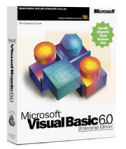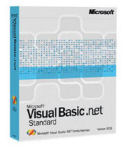Introduction to Visual Basic
People often ask "What is Visual Basic"? Visual Basic is a Microsoft Windows programming language and integrated development environment designed for rapid production of Windows applications. Visual Basic has deep roots in the popular BASIC language, and is designed for ease of use by Software Developers, Programmers, and Hobbyists from all different levels of experience.
Visual Basic is a fantastic tool for those beginning out in software development as it has a fast learning curve and enables developers to produce software applications very quickly (i.e. the time-to-market is very short). Visual Basic was a leader in the adoption of drag and drop Graphical User Interface (GUI) development and made it very simple to modify behaviour.
Visual Basic is not well suited large scale enterprise applications, and has been subject to criticism due to difficulties and problems that have arisen in VB applications. Visual Basic .NET successfully addresses a number of these scalability and quality problems, and is fast gaining notoriety amongst the software development community.
Ease of Use
Visual Basic was designed with simplicity in mind, providing users with a number of tools to simplify the development process. Windows are called forms and can be created simply by dragging and dropping form elements (called controls) onto the form. This allows for incredibly rapid user interface creation, and gives the window designer great power in the layout of their screens.
Form elements are extremely customisable and many properties can be controlled at design or runtime. Visual Basic applications are event driven, which allows developers to rapidly add behaviour to the graphical elements and develop a functioning system - often within minutes.
Programming Paradigm
Visual Basic is described as an event-driven programming language, and is often said to facilitate Rapid Application Development (RAD). Visual Basic shares many principles with Object Oriented languages, but until recently did not provide try object oriented functions.
Product Consistency
Microsoft has also designed the Visual Basic development environment to be similar to that in many other popular applications, including the Microsoft Office suite. Indeed, Visual Basic has so many similarities to Office that a derivative of the language was created for controlling behaviour for templates and documents called Visual Basic for Applications, or VBA.
Visual Basic 6.0 / .NET ?
The most widely used version of Visual Basic is Version 6.0. With the growth in enterprise application platforms many of the concepts and ideologies introduced in VB6 ran risk of being superseded. To counter this, Microsoft developed Visual Basic .NET, which is part of the Microsoft .NET platform.
.NET represents a significant paradigm shift from earlier versions of VB, retaining much of the simplicity and rapid properties of the earlier versions, but providing much richer and more powerful development capabilities. However, .NET has been slow to catch on, and Visual Basic Version 6.0 is still widely used in many situations in both personal and corporate environments.
How Do I Get Started?
The best way to learn the depths of Visual Basic is to explore the application yourself. The Visual Basic Purchasing Options provides details on how and where to purchase Visual Basic. Continue to explore the Learning Center and visit some of the other sites on this ring.
If you are serious about developing your Visual Basic skills, I highly recommend some further reading from our books section.
 |
 |
